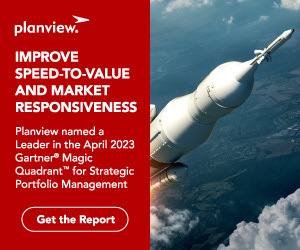
Effective strategic portfolio management (SPM) can increase revenue, market share, and speed of innovation – especially when paired with the right SPM software.
Strategic portfolio management is designed to drive today’s complex, cross-functional initiatives. It can be a great equalizer, enabling the organization to operate as a dynamic entity rather than a collection of silos.
However, SPM implementation isn’t a point-and-click process. It’s a journey that requires a paradigm shift for many companies. Lucky for you, we’ve identified the core components necessary for successfully implementing strategic portfolio management and utilizing SPM software in your company. But first, let’s take a brief look at what SPM is and what it isn’t.
The Differences Between Strategic Portfolio Management and Project Portfolio Management
Both SPM and PPM are vital for achieving the company’s initiatives but on different levels. Companies use PPM to manage project and work delivery on a functional scale. The focus is driving execution aligned with company strategy.
In contrast, strategic portfolio management looks at the bigger picture. Its domain is to help you plan and manage cross-functional programs and products linked to strategic objectives.
Using SPM, you can select, prioritize, and fund the investments that will have the most impact on the organization and orchestrate across teams to realize business outcomes.
Strategic portfolio management’s focus on outcomes differs from PPM. While project portfolio management may measure success via outputs such as lines of code and adherence to budget, SPM measures it by looking at the results delivered, such as sales growth and adoption.
With that said, having a solid foundation in PPM can help your company become better positioned when starting an SPM journey.
Why Your Organization Needs Strategic Portfolio Management
Strategic portfolio management garners insights derived from across the company. Practiced with the right technologies, SPM provides a constant pulse on the company’s resources, capacity, project status, and other factors – which are all fundamentally linked.
Having real-time intelligence yields many benefits. Here are a few of the main ones:
- Connect investments and work delivery to company strategy: This is a continuous process that keeps everyone and everything always aligned with strategy. The company can prioritize the highest-value initiatives and ensure execution based on strategic goals. SPM makes it easier to identify and swiftly address dependencies, risks, and constraints
- Respond to disruptions more quickly and effectively: Far from a reactive endeavor, SPM boosts the company’s agility. You can swiftly seize new opportunities, capitalize on emerging trends, and adapt to changes ahead; and do it and better than the competition
- Reduce your time to market: SPM equips your organization to deliver value to customers faster. Executives and managers can make quicker, more informed decisions. Teams are empowered to innovate, shift gears as needed, and get products and services out quickly
- Improve return on investment: Your company is more likely to achieve its strategic objectives for product usage, customer satisfaction, and other success metrics
And to get the best results out of your SPM software, you need a comprehensive strategic portfolio management solution that empowers your organization to transform and drive business value on your terms and timeline.
If you’d like to know more about SPM and what it can do for your organization, access our eBook titled “Align, Adapt, and Transform with Strategic Portfolio Management.” Learn how to advocate for SPM within your organization and how you can use it to turn your big-picture ideas into actual business value.
How can you put strategic portfolio management and your SPM software solution into action? Let’s look.
The Recipe for Success: Implementing SPM in Your Organization
We touched on what SPM is and what it isn’t. We looked at how SPM can benefit your organization. So, how do you actually implement it and start to see those benefits?
The first thing to remember is that a successful SPM transformation requires careful planning and execution. And every journey is as unique as the business embarking on that journey.
But you can get an idea of what yours may look like by reading about the strategic portfolio management maturity journey.
The takeaway? Your transformation may not look exactly the same as another enterprise’s one. With that said, we have identified five capabilities that are critical to the success of implementing SPM in your organization:
- Visibility
- Alignment between strategy and execution
- Agility
- Being data-driven
- Flexible, streamlined governance
These five elements are essential for maximizing the success of your SPM implementation. By creating a strategy that includes these core components and an effective SPM software solution, you can empower your organization to drive value, even when faced with change and disruption.
Accelerate Value and Achieve Your Big Picture Goals
Strategic portfolio management is a necessity for surviving and thriving in an environment of constant change. Companies can close the strategy execution gap and create a dynamic link between them. You can quickly make the shifts needed to address disruptions and capitalize on opportunities that bring value to your enterprise – all while helping you maintain your competitive edge.
In a professional landscape that’s constantly changing, why not evolve with it? You can drive strategy and achieve your business outcomes with strategic portfolio management.
Learn how to successfully implement SPM in your organization by watching our on-demand webinar titled 5 Critical Components of Successful SPM Implementation.




